1996 PONTIAC GRAND-AM steering wheel
[x] Cancel search: steering wheelPage 179 of 356
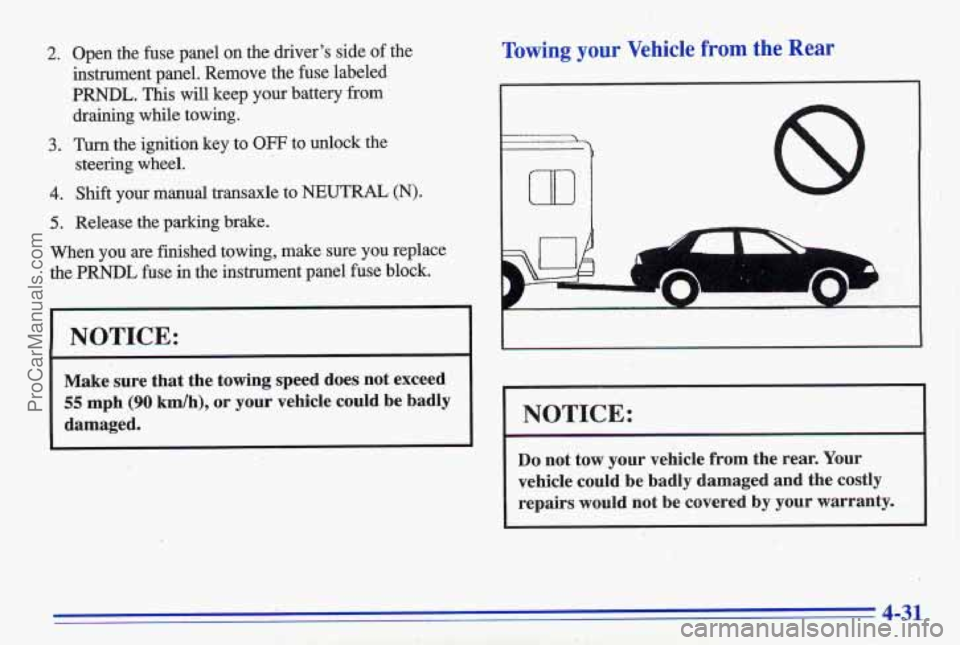
2.
3.
4.
5.
Open the fuse panel on the driver's side of the
instrument panel. Remove the fuse labeled
PRNDL. This will keep your battery from
draining while towing.
Tum the ignition key to OFF to unlock the
steering wheel.
Shift your manual transaxle to
NEUTRAL (N).
Release the parking brake.
When you
are finished towing, make sure you replace
the
PRNDL fuse in the instrument panel fuse block.
NOTICE:
Make sure that the towing speed does not exceed
55 mph (90 kdh), or your vehicle could be badly
damaged.
Towing your Vehicle from the'Rear
'b
8
,NOTICE:
~~ ~
Do not tow your vehicle from the rear. Your
vehicle could be badly damaged and the costly
repairs would not be covered by your warranty.
, .. P 'I
4-31
ProCarManuals.com
Page 186 of 356
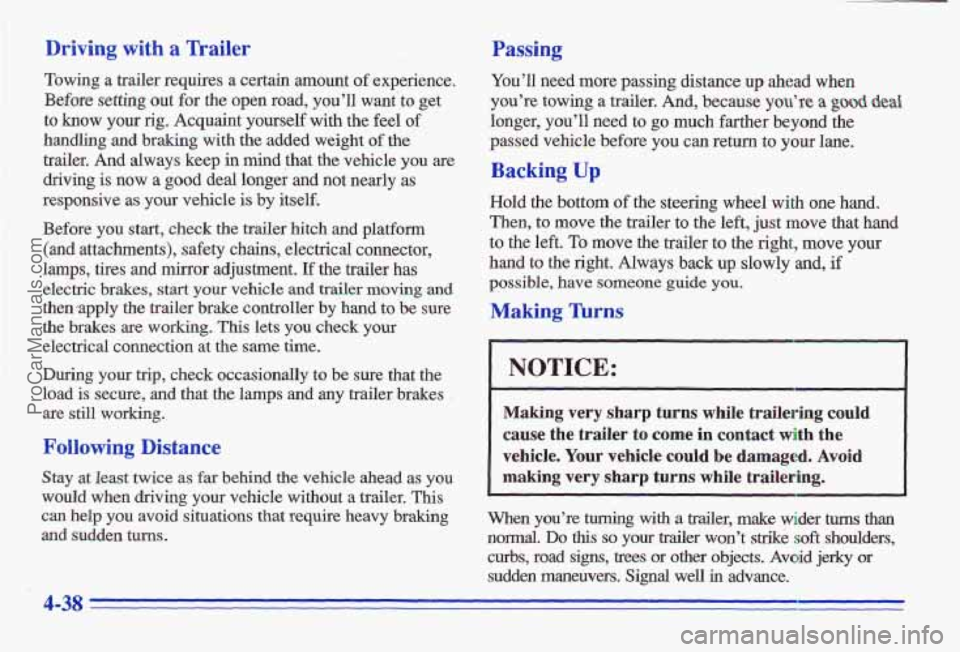
Driving with a Trailer
Towing a trailer requires a certain amount of experience.
Before setting out for the open road, you’ll want’to get
to know your rig. Acquaint yourself with the feel of
handling and braking with the added weight of the
trailer.
And always keep in mind that the vehicle you are
driving is now a good deal longer and not nearly as
responsive as your vehicle is by itselfi.
Before you
start, check the trailer hitch and platform
(and attachments), safety
chains, electrical connector,
lamps, tires and
mirror adjustment, If the trailer has
electric brakes, start your vehicle and trailer moving and
then/apply the trailer brake controller by hand to be sure
the brakes are working. This lets you check your
electrical connection at the
same tirne.
During your trip, check occasionally to be sure that the
load
is secure, and that the lamps and any trailer brakes ,
are still working.
Following Distance
Stay at least twice as far b’ehind the vehicle ahead as you
would when driving your vehicle without a trailer,
This
can help you avoid situations that require heavv braking
and sudden
turns.
Passing
You’ll need more passing distance up ,ahead when
you’re towing a trailer. And, because
you’re a good
longer, you’ll need to go much farther beyond the
passed vehicle before you can return to your lane.
Backing Up
Hold the bottom of the steering wheel with one hand.
Then, to move the trailer to the left, just move that
hand
to the left. To move the trailer to the right, move your
hand to the right. Always back up slowly and, if
possible, have someone guide you.
Making Thrns
I NOTICE:
Making very sharp turns while trailering could
cause th’e trailer to come in contact with the
vehicle. Your vehicle could be damaged. Avoid
making very sharp turns while trailering.
~ ~~ ~~ ~~~
When you’re turning with a trailer, make wider hms than
normal. Do this so your trailer won’t strike soft shoulders,
curbs, road signs, trees or
other objects. Avoid jerky or
sudden maneuvers.
Siggd well in advance.
4-38
ProCarManuals.com
Page 198 of 356
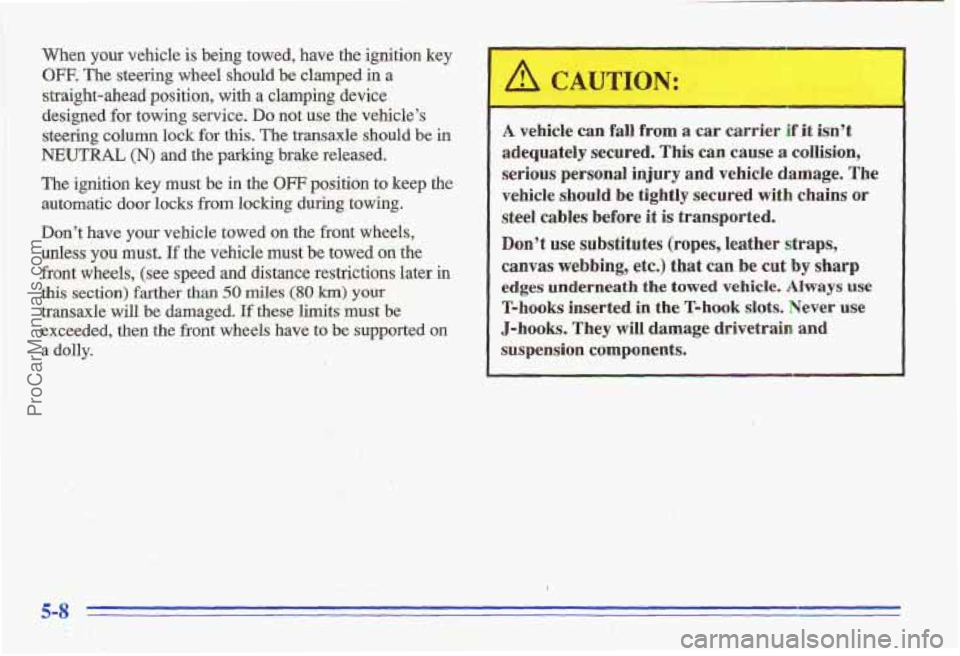
When your vehicle is being towed, have the ignition key
OFF. The steering wheel should be clamped in a
straight-ahead position, with
a clamping device
designed for towing service. Do not use the vehicle's
steering column lock
for this. The transaxle should be in
NEUTRAL (N) and the parking brake released.
The ignition key must be in the
OFF position to keep the
automatic
door locks from locking during towing.
Don't have your vehicle towed on the front wheels,
unless
you 'must. If the vehicle must be towed on the
front wheels,' (see speed and distance restrictions
later in
this section) farther than 50 miles (80 km) your
transaxle will be damaged. If these limits must be
exceeded, then
the front wheels have to be supported on
a
dolly.
r
A vehicle can fall from a car carr if it isn't
adequately secured.
This can cause a collision,
1 serious personal injury and vehicle damage. The
' vehicle should be tightly secured with chains or
steel cables before it is transported.
Don't use substitutes (ropes, leather straps,
canvas webbing, etc.) that can
be cut by sharp
edges underneath the towed vehicle. Always use
T-hooks inserted in the T-hook slots. Never use
J-hooks. They will damage drivetrain and
suspension components.
ProCarManuals.com
Page 211 of 356
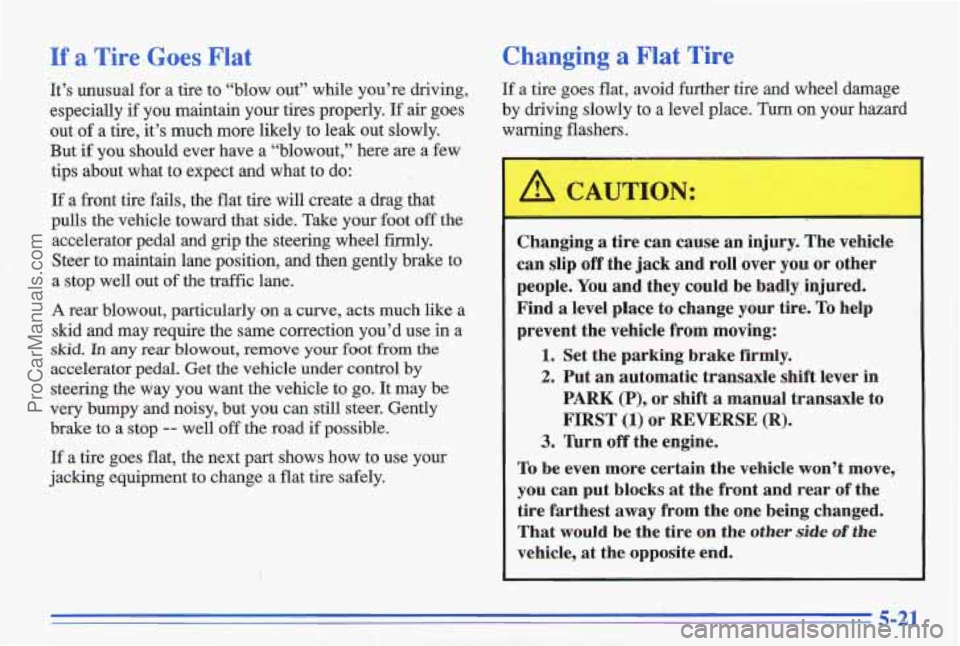
If a Tire Goes Flat
It’s unusual for a tire to “blow out” while you’re \
driving,
especially
if you maintain your tires properly. If air goes
out
of a tire, it’s much more likely to leak out slowly.
But
if you should ever have a “blowout,” here are a few
tips about what to expect and what to
do:
If a front tire fails, the flat tire will create a drag that
pulls the vehicle toward that side. Take your foot off the
accelerator pedal and grip the steering wheel firmly.
Steer
to maintain lane position, and then gently ‘brake to
a stop well out
of the traffic lane.
A rear blowout, particularly on a curve, acts much like a
skid and may require the same correction you’d use in a
skid. In my rear blowout, remove your foot from the
accelerator pedal. Get the vehicle under control by
steering the way you want the vehicle to
go. It may be
very bumpy and noisy, but you can
still steer. Gently
brake to a stop
-- well off the road if possible.
If a tire goes flat, the next part shows how to use your
jacking equipment to change a flat tire safely.
Changing a Flat Tire
If a tire goes flat, avoid further tire and wheel damage
by driving slowly
to a level place. Turn on your hazard
warning flashers.
Changing a tire can cause an injury. The vehicle
can slip
off the jack and roll over you or other
people.
You and they could be badly,injured.
Find
a level place to change your tire. To help
prevent the vehicle from moving:
1. Set the parking brake firmly.
2. Put an’automatic transaxle shift lever in
PARK
(P), or shift a manual transaxle to
FIRST (1) or REVERSE (R).
3. lbrn off the engine.
To be even more certain the vehicle won’t move,
you can put blocks at the front and rear of the
tire farthest away from the one being changed.
That would be the tire
on the other side of the
vehicle, at the opposite end.
5-21
ProCarManuals.com
Page 222 of 356
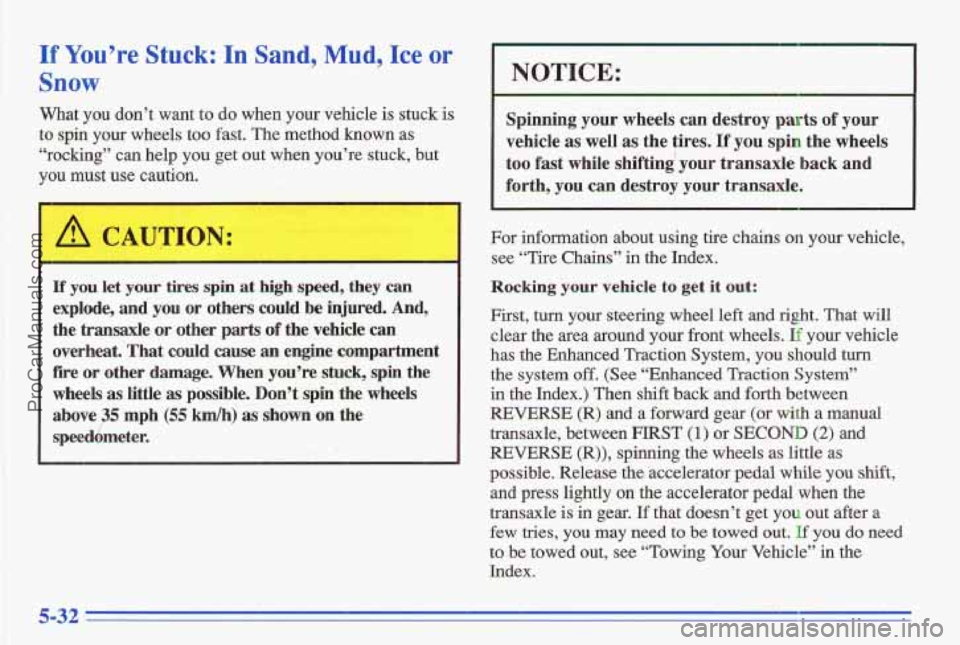
If You’re Stuck: In Sand,,Mud, Ice or
Snow
What you don’t want to do when your vehicle is stuck is
to spin your wheels too fast. The method known a,s
“rocking” can help you get out when you’re stuck, but
you must use caution.
/d CAUTION:
If you your .es spin at high speed, they can
explode, and you or others could be injured. And,
the tran,saxle or other parts of the vehicle can
overheat.
That could cause an engine compartment
fire or other damage. When you’re stuck, spin the
wheels
as little as possible. Don’t spin the wheels
above35 mph
(55 kdh) as shown on the
speedqmeter. Spinning
your wheels can destroy
parts of your
vehicle as well
as the tires. If you spin the wheels
too fast while shifting your transaxle back and
For information about using tire chains on your vehicle,
see “Tire Chains” in the Index.
Rocking y---r vehick ID get it out:
First, turn your steering wheel left and right. That will
clear the pea around your front wheels. If your vehicle
has the Enhanced Traction System, you should turn
the system
off. (See “Enhanced Traction System’’
in the Index.) Then shift back and forth between
REVERSE (R) and a forward gear
(or with a manual
transaxle, between FIRST
(1) or SECOND (2) and
REVERSE
(R)), spinning the wheels as little as
possible. Release the accelerator pedal
while you shift,
and press lightly on the accelerator pedal when the
transaxle is in gear.
If that doesn’t get you out after a
few tries, you may need to be towed out. If you do need
to be towe’d out, see “Towing Your Vehicle” in the
Index.
5-32
ProCarManuals.com
Page 279 of 356

Fuse
WIPER
02
,DR UNLK
ALARM
FOG/FTP
PRNDL
BR LK 2
AIR BAG
HORN
Usage
Windshield Wipers/Washers
Heated Oxygen Sensors Automatic
Door Unlock
Automatic Transaxle, Automatic
Door Unlock, Alarm Module
(Illuminated Entry, Warning
Chimes), TraGtion Telltale, Rear
Window Defogger, Remote
Keyless Entry
Fog Lamps
Instrument Cluster, Powertrain Computer, Park-Lock Solenoid,
Electronic
PRNDL
Door Locks
Air Bag-Power
Horn, Service Tool Power
Fuse Usage
INST Instrument Cluster
STOP
HAZ Stoplamps, Hazard Lamps,
Anti-Lock Brakes
PCM Powertrain Control Module
DR LK
1 Door Locks
INST
LPS Instrument Panel Lights, Fog
Lamps
RR DEF Rear Window Defogger
HDLP Headlamps, Daytime Running Lamps (Circuit Breaker)
Steering Wheel Controls (If Equipped)
Fuse Panel .. - / , . . , ;';,,;'.[ -: .f-, .-.;'.A, Li-v. I , , ~ I , , .,$! ::.
Your steering wheel radio controls are protected
by fuses. For service, contact your Pontiac
service department.
. ._ .,~ \. ~, ' ' ~ .j_ . ,:: :?<. , x:'. -.
6-57
ProCarManuals.com
Page 325 of 356
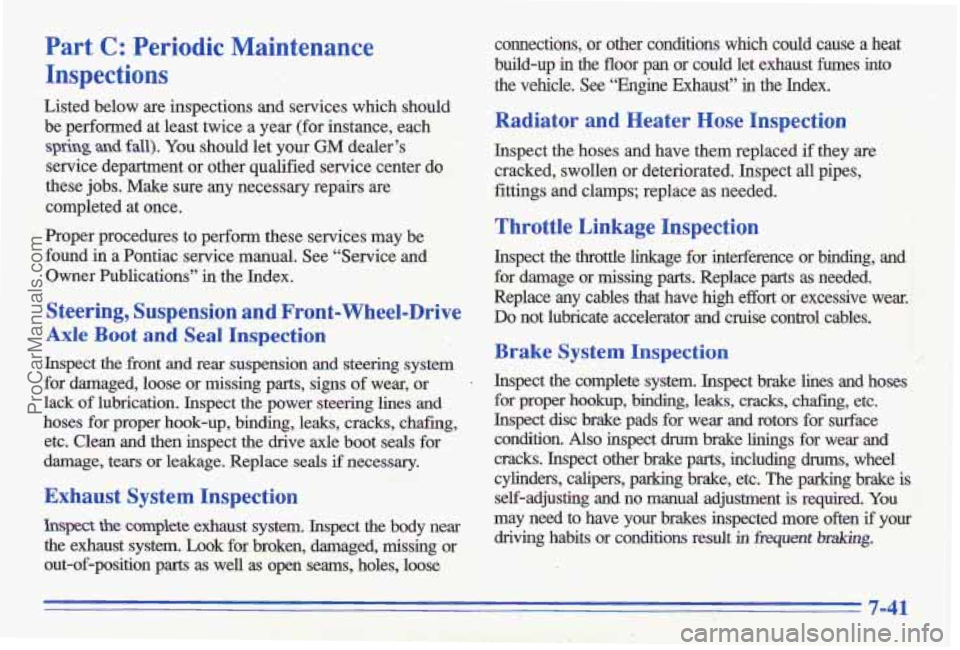
Part C: -Periodic Maintenance
Inspections connections, or other conditions which could cause a heat
build-up in
the floor pan or could let exhaust fumes into
the vehcle. See “Engine Exhaust”
in the Index.
Listed below are inspections and services which should
be performed at least twice a year (for instance, each
Radiator and Heater Hose Inspection
spxing and fall). You should let your GM dealer’+& ?::. Inspect the hoses and have them replaced if they are
service department or other qualified service center ,:5; 4
cracked, swollen or deteriorated. Inspect all pipes,
these jobs. Make sure any necessary repairs are fittings and clamps; replac\
e as needed.
completed at once.
Proper procedures to perform these services may be
found in a Pontiac service manual. See “Service and Inspect the throt\
tle linkage for interference or binding, and
. ..,..
Throttle Linkage Inspection
Owner Publications” in the Index.
Steering, Suspension and Front-Wheel-Drive
Axle Boot and Seal Inspection
Inspect the front and rear suspension and steering system
for.damaged, loose or missing parts, signs of wear, or
.
lack of lubrication. Inspect the power steering lines and
hoses for proper hook-up, binding, leaks, cracks, chafing,
etc. Clean and then inspect the drive axle boot seals for
damage,
tears or leakage. Replace seals if necessary.
Exhaust System Inspection
Inspect the colillplee exhaust system. Inspect the body near
the exhaust system. Look for broken, damaged, missing or
out-o€-position
parts as well as open seams, holes, loose fordamage
or missing parts. Replace parts
as needed.
Replace any cables that have high effort or excessive wear.
Do not lubricate accelerator and cruise control cables.
Brake System Inspection
Inspect the complete system. Inspect brake lines and hoses for proper
hookup, binding, leaks, cracks, chafhg, etc.
Inspect disc brake pads for wear and rotors for surface
condition.
Also inspect drum brake linings for. wear and
cracks. Inspect other brake parts, including
drums, wheel
cylinders, capers, parking brake, etc. The parking brake
is
self-adjusting and no manual adjustment is required. You
may need to have your brakes inspected more often if your
driving habits or conditions result
in fi-equent braking.
7-41
ProCarManuals.com
Page 343 of 356
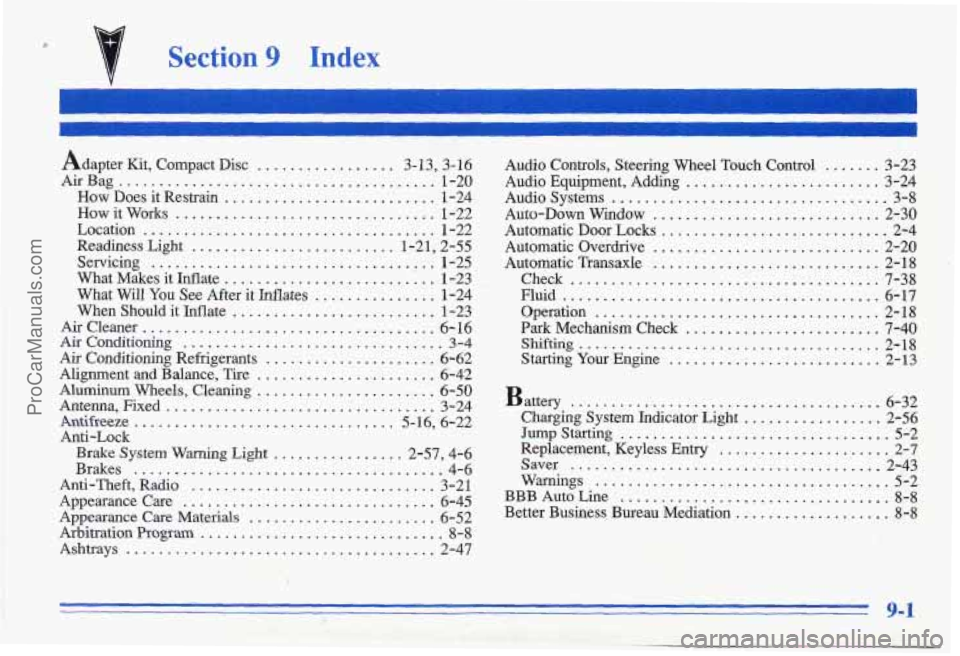
0
Section 9 Index
I
I
Adapter Kit. Compact Disc .................. 3- 13. 3. 16
Air Bag ....................................... 1-20
How Does it Restrain
.......................... 1-24
How it
Works ................................ 1-22
Location
................,..,................ l-22
Readiness Light ......................... 1-21. 2-55
Servicing ................................ .. 1-25
What Will You See After it Inflates
............... 1-24
When Should it Inflate
......................... 1-23
Air Cleaner ...................................... 6-16 Air Conditioning ................................ 3-4
Air Conditioning Refrigerants ..................... 6-62
Alignment and Balance, Tire
...................... 6-42
Aluminum Wheels. Cleaning ...................... 6-50
Antenna, Fixed ................................. 3-24
Antifreeze ................................ 5-16, 6-22
Anti-Lock
Brake System Warning Light ................ 2-57, 4-6
Anti-Theft, Radio
.............................. 3-21
Appearance Care Materials ....................... 6-52
Arbitration
Program .............................. 8-8
Ashtrays ...................................... 2-47
What Makes it Inflate
.......................... 1-23
Brakes
...................................... 4-6
Appearancecare
............................... 6-45 Audio Controls. Steering Wheel Touch Control
....... 3-23
Audio Equipment. Adding
........................ 3-24
Audio Systems
................................... 3-8
Auto-Down Window ............................ 2-30
Automatic Door Locks
............................ 2-4
Automatic Overdrive
............................ 2-20
Automatic Transaxle
............................. 2-18
Fluid
....................................... 6-17
Operation
.................................... 2-18
Park Mechanism Check ........................ 7-40
Starting Your Engine .......................... 2-13
Check
...................................... 7-38
Shifting ..................................... 2-18
Battery
...................................... 6-32
Charging System Indicator Light
................. 2-56
Jump Starting ................................. 5-2
Replacement. Keyless Entry
..................... 2-7
Saver ...................................... 2-43
Warnings .................................... 5-2
BBB Auto Line ................................. 8-8
Better Business Bureau Mediation ................... 8-8
.
.. .b... ... ...... :yv... .. ...
ProCarManuals.com